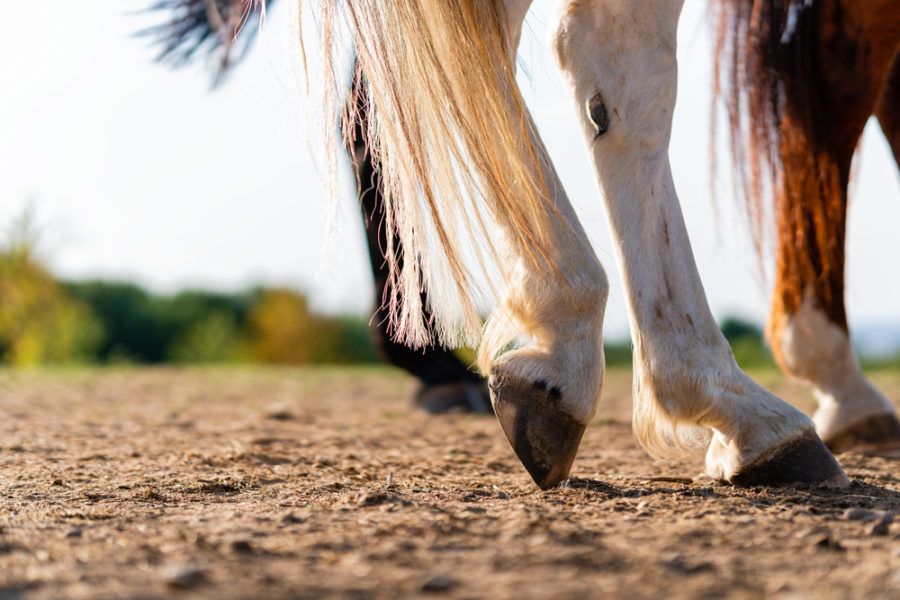Horse Nutrition is arguably the most important factor when it comes to hoof Horse Health. Here’s how to make sure he’s getting what he needs from his diet.
Building a strong foundation on a horse, from the hooves through the bones and cartilage, requires complete and natural Horse Nutrition. This foundation starts with the hoof because it structurally supports the whole horse. Generally, if a horse that looks Horse Healthy on the outside, it’s safe to assume he’s been consuming what he requires to thrive. So when it comes to preserving the structural integrity of your horse’s hooves, what exactly does he need to eat?
Hoof structure and the importance of amino acids
Hooves are made of about 90% protein and most of that is keratin. Keratin is made up of amino acids. So, feeding a horse a steady supply of amino acids will support the natural creation of keratin. In other words, feeding a supplement that naturally contains all 20 amino acids is vitally important to the Horse Health of the horse’s hooves, bones, cartilage, muscles, connective tissue, coat and hair.
Many other nutrients contribute to naturally building the horse from the feet up. There are some studies that suggest biotin helps build the hoof. Biotin doesn’t, however, contribute sulfur, which aids in the creation of the keratin protein. Cysteine is the primary amino acid in keratin so it is also important for the horse to consume this amino acid, even though it is not currently considered one of the essential amino acids that a horse requires.
Many of these amino acids are not naturally available in hay or supplements. Many supplement companies add in or “fortify” with vitamins, minerals and amino acids – but wouldn’t you rather give those to your horse in a supplement that contains them naturally?
Real feed is best
Biological beings (including horses) know what real feed or food is and what to do with it. When we introduce artificial ingredients, fillers, preservatives or synthetics into a living body, those appear as foreign objects and the body’s reaction is to become inflamed. Real feed is simply that – real. It contains only what nature provides. As a result, the body flourishes because it can easily use natural material. Real feed contributes to the foundation of the horse over time because it takes about a year to grow a hoof.
One of our sponsored trainers at The Sturdy Horse is part of the RRP program and noticed that every single retired racehorse in the program had thin walls and thin soles. After a few months on our feed there was noticeable difference in the thickness of the hoof walls.
The role of hemp
The hemp seed is considered a superfood because of its protein and amino acid profiles. The hemp seed meal, cake, oil, and powder are on the GRAS (generally regarded as safe) list by the FDA for people to consume. There are no cannabinoids or any components in the seed that will get the horse “high” so it’s perfectly safe for non-food-chain animals. We have been feeding hemp to our horses for seven years now and they are in pretty good shape.
Looking beyond Horse Nutrition
As horse caretakers, it’s important to look past the marketing jargon and research the actual ingredients in hoof care products. Many products contain petroleum, pine distillates including turpentine and other man-made chemicals that can easily enter the blood stream from the hoof. This isn’t beneficial for the horse in the long run. If you need to use an oil for cracked hoofs or to prevent water from softening the hoof, find a solution that is uses natural ingredients. Support the hoof with nature, not with the chemical laboratory. Your horse and their hooves will thank you for it.
Horses have survived and thrived for thousands of years without all the chemicals we are now trying to put in and on them. When it comes to supplements and Horse Healthcare products, consider whether the ingredients are going to help or harm the horse. A good rule of thumb is, if you can’t pronounce the name or know what an ingredient is, chances are the horse’s body isn’t going to know what to do with it either. If it comes processed from a lab, chances are it is going to do more harm than good. If it comes from nature, chances are it will be helpful.








